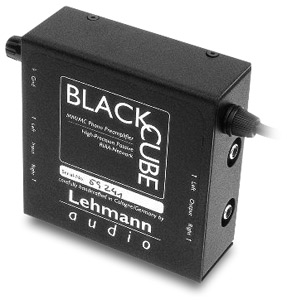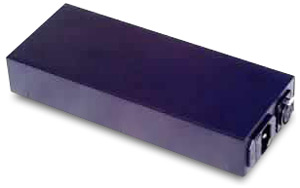![[SoundStage!]](../sslogo3.gif) The Vinyl Word The Vinyl WordBack Issue Article |
|||||||||||||||||
June 2003
Lehmann Audio Black Cube SE Phono Stage by Andrew Chasin
Even though I felt the original Black Cube sounded far better than it had any right to for its paltry $695 USD asking price, I always wondered if its tiny power supply, encased in a cheap, plastic housing, was holding it back from reaching its full potential. I was pleasantly surprised, then, when I learned of the Special Edition, or SE, version of the Black Cube, which featured a much more ambitious power supply design, premium parts, and the promise of "far greater dynamics" and "better imaging." Well, isn’t that special The SE version of the Black Cube jettisons its tiny power supply in favor of a much larger, 30VA high-current power supply, dubbed the PWX, featuring a "protection coil between [the] primary and secondary coil, filtering away common mode interferences." The plastic casing is now replaced by a larger, damped aluminum one (available in any color, as long as it’s black) measuring 3 1/2"W x 1 3/4"H x 9"D that can more easily accommodate the larger transformer used in the SE. The power supply is connected to the business portion of the phono stage via a two-meter umbilical cable terminated with a four-pole XLR connector at the power-supply end. The cable is fixed permanently to the Black Cube SE at the other end. As was the case with the original Black Cube, the supplied power cord is detachable so that an after-market cord may be substituted in its place, although I chose to use the stock cord for the purposes of this review. All of the notable features of the original Black Cube are retained in the SE version -- namely switchable gain to accommodate both moving-magnet and moving-coil cartridges (40dB for the MM input, 61dB for the MC); three pre-set loading options of 47k ohms, 470 ohms, and 100 ohms selectable via a set of DIP switches mounted to the Cube’s main circuit board; as well as a custom loading slot into which a resistor of the user’s choosing may be inserted. Accessibility to the DIP switches used to select the input-loading value has been improved by exposing them through an opening in the bottom of the Black Cube’s aluminum casing (owners of the original Black Cube could only gain access to the switches by removing the top portion of the casing.)
The Black Cube SE costs $895, but in a move sure to please owners of the original Black Cube, Lehmann Audio offers the PWX as an upgrade to the non-SE Black Cube for $299. Since some soldering is required to add the PWX, the upgrade is probably best left to an authorized dealer. Review context I recently made some significant changes to my audio system and listening environment that are worth noting. First, the Audible Illusions Modulus 3A preamplifier that I’ve used for the past five years has been replaced by the superb Hovland HP-100 with built-in moving-coil phono stage. While I thoroughly enjoyed my years with the Modulus 3A and still recommend it very highly, the HP-100 significantly improves upon the 3A in nearly every way. Second, the Graham phono cable has been retired in favor of the terrific Hovland Music Groove-2. Lastly, I’ve moved my system into a smaller, but dedicated, listening room measuring approximately 13' x 15'. The new room is fully carpeted and seems to have a more natural decay characteristic than my previous 20' x 20' combined living/listening room with hardwood floors. Moving to smaller quarters, however, mandated a loudspeaker change. While I fell head over heels for the awesome Magnepan MG3.6/Rs that I reviewed last year, I decided that a small monitor would be much more appropriate in the new space, and I settled on a longtime favorite, the ProAc Response One SC. What the One SC lacks in bass extension it more than makes up for in midrange purity and ribbon-like high-frequency extension and transparency. The One SCs are supported by sand-filled Target R4 speaker stands (sadly now discontinued), to which they are coupled with a few blobs of Blu-Tack. The rest of my system remains unchanged. Primary source is the VPI Aries turntable with Mk.V platter and bearing upgrade, SDS power supply, Graham 2.0 tonearm, and Transfiguration Spirit moving-coil phono cartridge. Power amplifier is the Simaudio Moon W-5. All cabling, other than phono, is by Harmonic Technology, and all components are placed on a Finite Element Pagode Master Reference rack. Listening Having recently spent considerable time with the superb Lamm Industries LP2 phono stage, and having lived with the stellar Hovland HP-100 with internal MC step-up transformer for the past few months, I assumed that the relatively inexpensive Black Cube SE would be a letdown. Nothing could have been further from the truth. While the Black Cube SE couldn’t match the resolution and overall refinement of either the LP2 or the Hovland (nor did I expect it to), it was a highly musical performer that artfully hid its few weaknesses behind considerable strengths. Since I didn’t have the original Black Cube on hand for comparison, nor was it possible to remove the hard-wired PWX power supply from the SE in favor of the old supply, it was difficult to precisely assess the PWX’s contribution to the sound of the Black Cube. In absolute terms, however, the Black Cube SE greatly impressed me with its terrific dynamic abilities, an area of the original Cube’s performance that Lehmann Audio intended to address with the addition of the PWX. The orchestral swells leading up to the conclusion of Ravel’s Alborado del Gracioso [RCA/Classic Records LSC-2222] had terrific speed and attack, as did the muted trumpet staccatos heard repeatedly throughout the piece. I was also taken by the way in which the Black Cube SE credibly portrayed the leading edge of guitar transients. The picked acoustic guitar on "Hey Hey" from Eric Clapton’s venerable Unplugged [Reprise 9362-45024-1], for example, had the requisite edge definition without the nasty bite that can be heard with lesser phono stages. The same held true for the hard-strummed guitar chords that open "Sky Blue" from Peter Garbriel’s Up [Classic/Real World PGDLP 7243 8 1 13062 15]; the SE delivers a nice one-two combination of fast rise time followed by natural decay. Detractors of the original Black Cube pointed to an unnatural zippiness on transients and a bit of brightness in its overall presentation. While I didn’t find the original Black Cube to consistently possess these qualities (unless I got heavy-handed with the volume control), the SE did seem to have a smoother, more refined way with the leading edges of transients, at least in the context of my current system. If the original Black Cube proved too bright for your tastes and associated components, I’d suggest you give the SE a spin before moving up-market to more expensive contenders. One of the many strong points of the original Black Cube was its midrange performance. Although a hint of leanness could creep into its presentation on occasion (I doubt the Black Cube was ever confused with a tubed phono stage), it was primarily very neutral and highly transparent. The SE possessed the same high level of midrange transparency and neutrality as the original Black Cube, but it had more of a flesh-on-bone quality that the original lacked. Listening to Norah Jones’s Come Away With Me [Classic/Blue Note JP 5004] through the SE, I was presented with a more organic picture of the lovely singer/songwriter, one composed of a head, neck and chest cavity rather than just a disembodied voice hanging in air. This intangible "human" quality is what a well-engineered analog playback chain is capable of conveying (and what even the best digital systems still lack in my opinion), and I was rather surprised that this quality remained intact via the sub-$1000 Black Cube SE. The Black Cube SE continued the Black Cube tradition of excellent bass extension and definition, at least to the low-frequency limit imposed by the ProAc Response One SC. While perhaps not in the same league as the far more expensive Lamm LP2 (which delivered the best bass performance of any standalone phono stage I’ve heard, and it’s an all-tube unit to boot) or the Hovland preamp's MC stage, the SE was not terribly far behind, and, if aural memory serves, it managed to better the original Black Cube in low-frequency pitch definition. The SE easily revealed the distinct pitches of the myriad low-frequency percussion instruments on "Burabampo (The Deer)" from Strunz and Farah’s superb Misterio [Water Lily Acoustics WLA-CS-08], and delivered a potent punch when the drums were fiercely pounded at the work's climactic conclusion. If I were to put the Black Cube SE under the sonic microscope, I’d have to point out that it did not reveal as much recorded detail as the Lamm LP2 or the Hovland, nor did it shine as bright a light on the far reaches of the soundstage. In addition, the Black Cube slightly blurred image outlines relative to its more expensive competition. On "Signe" from Clapton’s Unplugged, for example, the wood block struck at the rear of the soundstage lacked the last ounce of percussive impact, and the background singers on "Layla" lacked the same degree of focus heard through both the LP2 and the HP-100. These relative shortcomings aside, the Black Cube SE was a highly musical performer and never failed to deliver the musical message. The fact that I’d even discuss the budget Black Cube SE in the same breath as the Lamm LP2 and Hovland HP-100 is testament to its exceptional overall performance. Comparisons Although it’s been quite a while since I’ve heard the original Black Cube, and my system has undergone some changes since that time, the Black Cube SE struck me as a much more accomplished overall performer. The SE retained all of the strong points of the original Black Cube while improving upon some of its weaknesses, including the original’s slightly bright presentation when pushed hard and its penchant for thinning out midrange textures. The SE was also extremely lively and dynamic and had excellent bass extension, no doubt due to the addition of the considerably beefier PWX power supply. The Musical Surroundings Phonomena is one of the few available Black Cube competitors in the under-$1000 category. Unfortunately, I haven’t spent time with the Phonomena in my system, so I can’t draw any direct sonic comparisons. The Phonomena, however, certainly does appear worthy of consideration for anyone shopping in the below-stratospheric price bracket. It offers adjustable gain from 40-60dB in 16 steps (compared to the fixed 40dB and 61dB settings of the Black Cube SE), adjustable loading from 30 ohms to 100k ohms in 128 steps, dual-mono construction, and class-A operation. The availability of a battery power supply (at a cost of $600) gives owners an attractive upgrade path, and an innovative way to combat noise injected into the sensitive analog playback chain from the power line. While the solid-state Black Cube SE already possesses a very low noise floor, a battery supply would be a most intriguing addition. When pitted head to head with the far-more-expensive Lamm LP2 and the excellent Hovland MC phono stage, the Black Cube SE hung tough but couldn’t match the same level of detail retrieval, transparency, or overall refinement. In absolute terms, however, the Black Cube SE delivered the bulk of the musical goods and, like the original Black Cube before it, proved a formidable performer at a real-world price. Conclusions With the addition of the PWX power supply, Lehmann Audio has improved the already-excellent Black Cube. Better yet, owners of the original Black Cube can upgrade to the PWX power supply for a mere $299 and get all the benefits of the upgraded supply. No, the PWX doesn’t turn the Black Cube into the Lamm LP2, but it does take the Black Cube to the next sonic level and, with its flexible gain and loading features, it could be all the phono stage many audiophiles will ever need. ...Andrew Chasin
|
|||||||||||||||||
|
|||||||||||||||||
![[SoundStage!]](../sslogo3.gif) All Contents All ContentsCopyright © 2003 SoundStage! All Rights Reserved |



